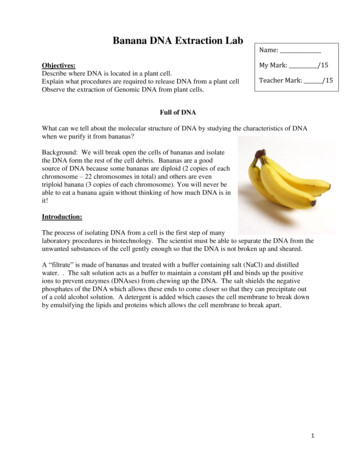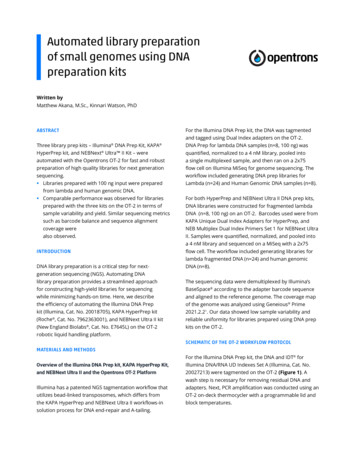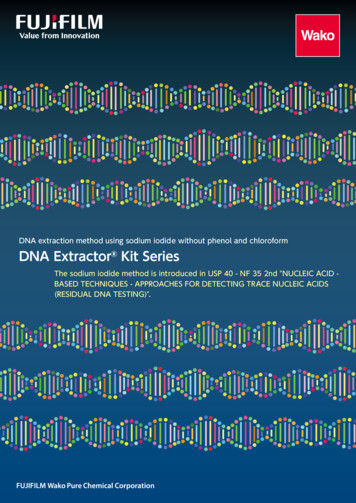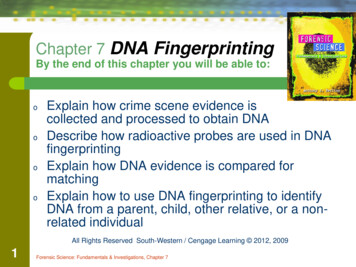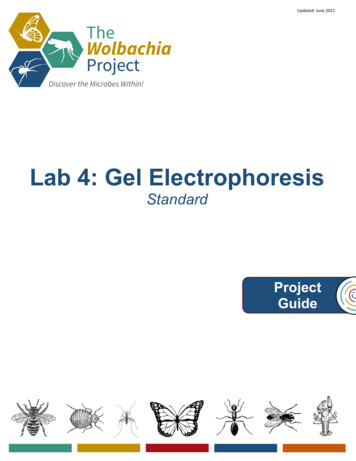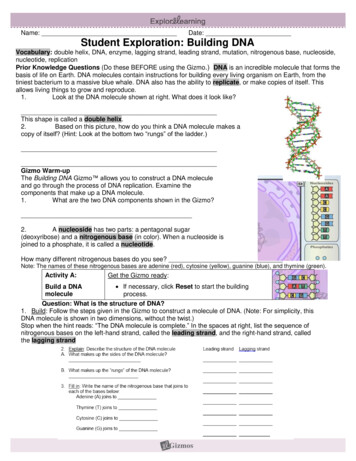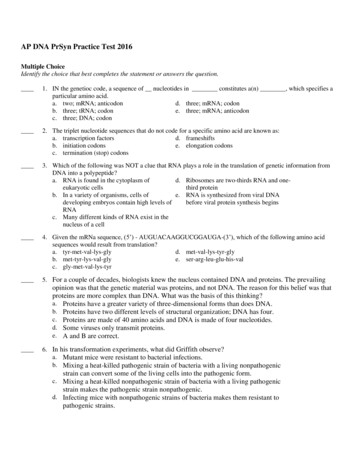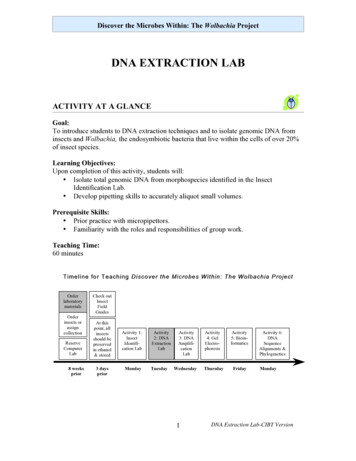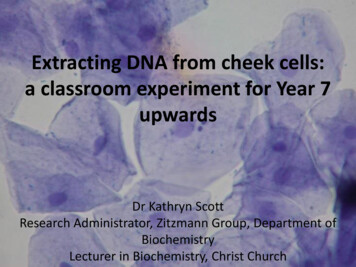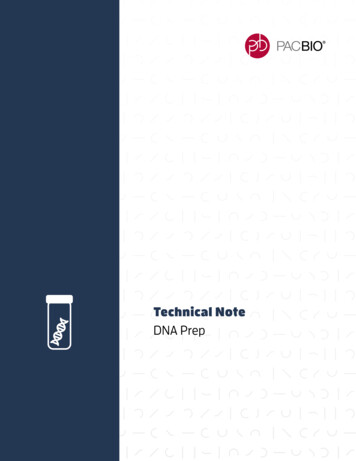
Transcription
Technical NoteDNA Prep
Technical NoteDNA PrepPreparing DNA for PacBio HiFi Sequencing —Extraction and Quality ControlIntroductionSingle Molecule, Real-Time (SMRT ) Sequencing uses the natural process of DNA replication to sequence longfragments of native DNA in order to produce highly accurate long reads, or HiFi reads. As such, starting with highquality, high molecular weight (HMW) genomic DNA (gDNA) will result in longer libraries and better performanceduring sequencing. This technical note is intended to give recommendations, tips and tricks for the extraction of DNA,as well as assessing and preserving the quality and size of your DNA sample to be used for HiFi sequencing.Topics CoveredDNA Extraction Commercially available kits across a wide variety of input sample typesResource for alternative DNA extraction methodsDNA Quality Control (QC) DNA quantification, purity, size, and damageUse of nucleic acid stabilizersDNA storage and shippingBest Practices for DNA Extraction for PacBio SequencingExample Dataset Using Commercial DNA Extraction Kits for PacBio SequencingDNA ExtractionSimple and easy-to-use commercial DNA extraction kits are an excellent way to produce HiFi reads on the Sequel and Sequel II Systems. The following are a list of kits that our customers have used in combination with the SMRTbell Express Template Prep Kit 2.0 protocol for high yields and consistent sequencing results. Sample amounts and typicalyields are based on each kit’s manufacturer. Check with each manufacturer for the most up-to-date information andrecommendations. DNA yields will vary by sample quality, type, and input amount.KitQIAGEN MagAttract HMW DNA KitMethodMagnetic beadQIAGEN PAXgene Blood DNA KitPrecipitationQIAGEN Gentra Puregene KitPrecipitationQIAGEN Genomic-tip 20/G KitAnion exchangecolumnCirculomics Nanobind CBB KitNanobind discSample AmountTypical Yields Blood: 200 mL Bacterial cells: 2 x 109 Tissue: up to 25 mg Blood: 8.5 mL 150-500 µg depending on the number ofnucleated cells Cells: 106 - 2.2*107 Tissue: up to 100 mg 7 µg per 1 million cells Tissue: 5-100 µg 1-20 µgBlood: 1 mLCells: 5 x 106Yeast: 1.5 x 109Bacteria: 4.5 x 109Tissue: up to 20 mg Blood: 200 mL Cells: 1 x 106 Bacteria: 5 x 108 - 5 x 109Blood: 4-8 µgGram-negative bacteria: up to 14 µgGram-positive bacteria: up to 3.5 µgTissue: 0.5-2.8 µg / mg tissue 5-34 µg depending on sample type andinput amount
Technical NoteDNA PrepKitMethodSample AmountCirculomics Nanobind TissueBig DNA Kit Depends on tissue andpreservation method; typicallyaround 25 mg 5-100 µgNanobind discCirculomics Nanobind Plant NucleiBig DNA KitNanobind disc Up to 10 g 5-20 µg Cells: 1 x 106 Blood: 200 mL Bacteria: 3.5 x 106 Cells: 3-12 µg Blood: 3-9 µg Bacteria: 1.3-1.6 µg Blood: 100 mLBacteria: 2 x 109Cells: 5 x 106Tissue: 10 mg Blood: 2 mLPlant: 1.5 g of leavesBacteria: up to 100 mgCells: 107Animal tissue: up to 300 mg Dependent on sample type and inputamountLucigen MasterPure KitNEB Monarch Genomic DNAPurification KitPrecipitationAnion exchangecolumnTypical YieldsBlood: 2.5-4 µgGram-negative bacteria: 6-10 µgGram-positive bacteria: 6-9 µgMammalian cells: 7-9 µgTissue: 5-30 µgMacherey-Nagel NucleoBondHMW DNA KitAnion exchangecolumnQIAGEN DNeasy PowerMax Soil KitBead-beating;Anion exchange Soil: up to 10 g Sample dependentQIAGEN QIAamp PowerFecal DNA KitBead-beating;Anion exchange Stool or biosolids: 250 mg Sample dependentThere are many alternative methods of DNA extraction not covered above. See www.extractdnaforpacbio.com as aresource database of customer protocols for DNA extraction for different organisms.DNA QCThere are multiple aspects of DNA quality that can have an impact on the final sequencing result. Below areimportant guidelines and considerations to follow for the different aspects of DNA quality. This includes measuringDNA concentration, assessing DNA purity and molecular weight, and minimizing DNA damage.QuantificationWe recommend using a fluorometric method that specifically measures only double-stranded DNA (dsDNA). Themost accurate and convenient way to do this is to use the Qubit fluorometer (ThermoFisher Scientific) with either theBroad Range (BR) or High Sensitivity (HS) dsDNA assay kits. The NanoDrop Spectrophotometer (ThermoFisherScientific), commonly used for DNA quantification, is good for assessing DNA purity (see below) but measures allnucleic acid in solution and therefore frequently overestimates the true concentration of dsDNA in a sample.If you are trying to quantify HMW DNA that is viscous, typically 100 kb in size on average, then we recommenddiluting a small aliquot and pipette up and down 10-20 times to shear and better homogenize the DNA in solution.For even more accurate quantification, consider making 3 aliquots and take the mean of all three readings. The CVbetween the three readings should be less than 30%. If not, try additional mixing of the samples to homogenize theDNA, and repeat quantification.PurityDNA purity is the single largest factor affecting the success of your sequencing experiment. We recommendassessing DNA purity by measuring the absorbance at 230, 260, and 280 nm using the NanoDrop system. Pure DNAwill have an A260/280 absorbance ratio of 1.8, and an A260/230 ratio of 2.0 or higher. A260/280 ratio below 1.8indicates contaminating protein or phenol that is absorbing at 280 nm, or noise from a very low DNA concentration.High ratios ( 1.8) may not indicate a problem, but the spectral profile should be reviewed for abnormalities. Commoncauses of a low A260/230 ratio are carryover contaminants such as carbohydrates (e.g. in mature plant tissue),phenol, residual guanidine or ethanol from a column-based kit, and residual glycogen from precipitation. A highA260/230 ratio doesn’t indicate carryover contaminants, rather it may indicate blanking with the wrong solution, not
Technical NoteDNA Prephaving the instrument well-calibrated, or a dirty pedestal. Again, the spectral profile should be reviewed for anyabnormalities. In addition, absorbance measurements on the Nanodrop system are sensitive to pH, so ensure that theDNA is suspended in a proper buffer solution such as the PacBio Elution Buffer.Another quick and very effective check for sample purity is to compare the concentration readings between theNanoDrop Spectrophotometer and Qubit Fluorometer. Despite the difference between how the systems estimateconcentration, pure, high-quality DNA should show relative agreement in concentrations. If you observe a largedifference in the concentration readings between the NanoDrop and Qubit systems, for example a difference ofgreater than or equal to 50% of the Qubit dsDNA assay reading, first check for RNA contamination using the QubitRNA broad range assay. If there is no RNA contamination, then we recommend doing at least one to three rounds ofa standard 0.45X AMPure PB bead purification until the concentrations are less than 50% different1. If the agreementdoes not improve after three rounds of purification, try using either a commercial kit, isopropanol precipitation, ornew DNA extraction method to get cleaner DNA. If there is RNA in the sample, then treat with RNase A followed by astandard 0.45X AMPure PB bead purification.Figure 1. Recommended cleanup process for isolated DNA.1 See the Concentrate DNA using AMPure PB Beads section of the Preparing HiFi SMRTbell Libraries using SMRTbell Express Template Prep Kit 2.0 protocol fora 0.45X AMPure PB cleanup procedure.
Technical NoteDNA PrepSizeOur new HiFi read-based applications on the Sequel II System have made gDNA molecular weight requirements lessstringent than previous applications that relied on traditional long-read sequencing. Our current recommended HiFilibrary insert sizes for de novo assembly range from 10–25 kb. Despite the smaller insert sizes, we still recommendstarting with gDNA 40 kb in size, on average, so that the size distribution of the library can be more narrowlyfocused with DNA shearing. In addition, the molecular weight of a sample is a good indicator of whether a samplehas experienced significant damage. For example, degraded samples are much more likely to have significant DNAdamage that can reduce read length and yield during sequencing, in addition to having overall lower insert sizes.Starting with a HMW sample will ensure that the sample is high quality and will sequence well. Please see individuallibrary preparation protocols for application-specific gDNA size recommendations and the best tools to use toaccurately measure the molecular weight.In addition, customers have reported that allowing HMW DNA pellets to resuspend (in a low-salt buffer) at roomtemperature for one to three days improves the yield of DNA in solution and average molecular weight.Also, precipitation and nanobind disks methods tend to yield higher molecular weight DNA than anion-exchange(column) and magnetic bead-based methods. This is primarily due to the latter methods having greater mechanicalforces that shear the gDNA. Moreover, gentle handling of the gDNA, the use of wide-bore pipette tips, and avoidingvortexing will all help improve the overall molecular weight of the DNA.DNA DamageNuclease InactivationWe recommend using a DNA extraction method that includes proteinase K, or another type of protease, during lysisto inactivate native nucleases. Substituting a chaotropic agent for a protease, such as guanidinium thiocyanate, hasresulted in samples with reduced sequencing performance. For tissue samples, it’s important to flash-freeze thesample immediately upon extraction, or death, in order to prevent DNA degradation. Moreover, we also recommendcutting the tissue into small pieces, or grinding to a fine powder in liquid nitrogen, in order to allow proteinase K toreach the lysed cells.Phenol/ChloroformWe also recommend avoiding extraction methods that use phenol/chloroform. These chemicals are strong oxidizersand can significantly damage the DNA if not properly used. For example, guanine is particularly sensitive to oxidationand exposure to phenol/chloroform can form 8-oxo-G bases. Despite the risks, we understand that in somecircumstances phenol/chloroform may be required to remove certain compounds from organisms where DNAextraction is a challenge. If you are working with an organism for which the DNA extraction method requires the useof phenol/chloroform, then take care not to expose the DNA to these agents longer than necessary and considerusing phase-lock tubes to better separate the aqueous and organic layers.Hydrolysis of N-glycosyl BondsThe most frequent type of DNA damage is the hydrolysis of the N-glycosyl bond, which creates an abasic site. Thesesites can then further degrade into nicks. Nicks in turn can make the DNA more susceptible to fragmentation. If notrepaired, nicks will also adversely affect sequencing performance. Exposure to heat or changes in pH will acceleratethe hydrolytic reactions. When working with HMW DNA it is best to minimize incubation times at high temperaturesand always store the DNA in a buffered solution. Regardless, abasic sites and nicks will accumulate over time, even inlyophilized material, since it’s practically impossible to rid the DNA of H2O, the reactive species. For best possiblesequencing results always use freshly isolated DNA.Tissue and Nucleic Acid StabilizersIn general, tissue preservatives such as ethanol, DMSO, or a commercial solution result in significantly lower qualityDNA than using fresh or flash-frozen tissue. If using a preservative is necessary, we recommend storing the tissue at4 C, as opposed to room temperature ( 21 C). This should improve the molecular weight and quality of the DNAisolated from the tissue.We have not tested commercial nucleic acid stabilizes (e.g. DNAgard and RNAlater) on sequencing performance, andtherefore cannot support their use with DNA or RNA samples at this time.
Technical NoteDNA PrepDNA Storage and ShippingPure gDNA suspended in a buffered solution, such as PacBio Elution Buffer, can be safely stored at 4 C for severalweeks to months. For long-term storage (months) we recommend freezing the DNA at -20 C or below and avoid freezethaw cycles. Freezing will induce some low-level of shearing from the ice-crystals.When shipping, we recommend DNA and SMRTbell libraries be shipped frozen on dry ice. Keeping the DNA, or library,frozen helps prevent shearing which can occur from the jostling experienced during shipping.Summary of Best Practices for DNA Extraction for PacBio HiFi Sequencing Use fresh or flash-frozen tissueStore flash-frozen tissue at -80 C and avoid freeze-thawcyclesDo not store blood samples longer than a week at 4-8 Cbefore DNA extractionGrind tissue samples to a fine powder in liquid nitrogenInactivate nucleases and DNA binding proteins with aprotease, such as proteinase KRemove all RNA with RNase AAvoid guanidinium or guanidine thiocyanate (proteasesare favored over chaotropic agents) Avoid oxidative agents such as phenol and/orchloroform to minimize DNA damageResuspend, or elute, DNA in a low salt buffer, such as10 mM Tris-HCL pH 8.5-9.0Check concentration on both the NanoDrop and Qubitsystems for concordanceEnsure DNA is pure with A 260/280 ratio at 1.8, and a A 260/230ratio greater or equal to 2.0Proceed to SMRTbell library preparation with freshlyisolated DNAExample: California Redwood Sample using Circulomics Nanobind Plant NucleiBig DNA KitThe Circulomics Nanobind Plant Nuclei Big DNA Kit was used to isolate DNA from 10 g of fresh leaf tissue of Sequoiasempervirens. The DNA library was prepared following the protocol titled Preparing HiFi SMRTbell Libraries usingSMRTbell Express Template Prep Kit 2.0 and a 17 kb fraction was size-selected on the BluePippin system (SageSciences). Sequencing was performed on the Sequel II System with v8.0 software and sequencing chemistry 2.0.Sequencing run time was 30 hours, with a 1-hour pre-extension prior to acquisition. CCS analysis was performed inSMRT Link v8.0 with default parameters using a minimum 3 pass, Q20 filter. Shown is data from a single SMRT Cell8M loaded at 60 pM.SampleTotal Bases (Gb)Polymerase ReadLength N50 (bp)HiFi ReadsHiFi SequencingYield (bp)HiFi Read LengthMean (bp)HiFi Read Quality(median)S. 127Q27Figure 2. Femto Pulse system (Agilent) electropherogram of the S. sempervirens gDNA isolatedwith the Circulomics Nanobind Plant Nuclei Big DNA Kit. The majority of the gDNA is 100 kb in size.
Technical NoteDNA PrepFigure 3. Femto Pulse system (Agilent) electropherogram of the S. sempervirensgDNA sheared to a mode of 25 kb on the Megarupter 3 system (Diagenode).Figure 4. Femto Pulse system (Agilent) electropherogram of the S. sempervirens size-selected SMRTbelllibrary. Black and blue lines are the size-selected SMRTbell libraries using the Sage BluePippin systemwith a high-pass 17 kb cutoff. The red and orange lines are the pre-size-selected SMRTbell library.For Research Use Only. Not for use in diagnostic procedures. Copyright 2020, Pacific Biosciences of California, Inc. All rights reserved. Information in this document is subject to change withoutnotice. Pacific Biosciences assumes no responsibility for any errors or omissions in this document. Certain notices, terms, conditions and/or use restrictions may pertain to your use of PacificBiosciences products and/or third party products. Please refer to the applicable Pacific Biosciences Terms and Conditions of Sale and to the applicable license terms at -conditions-of-sale/.Pacific Biosciences, the Pacific Biosciences logo, PacBio, SMRT, SMRTbell, Iso-Seq, and Sequel are trademarks of Pacific Biosciences. Pacific Biosciences does not sell a kit for carrying out the overallNo-Amp Targeted Sequencing method. Use of the No-Amp method may require rights to third-party owned intellectual property. BluePippin and SageELF are trademarks of Sage Science. NGS-goand NGSengine are trademarks of GenDx. Femto Pulse and Fragment Analyzer are trademarks of Agilent Technologies Inc. All other trademarks are the sole property of their respective owners.PN: TN101-061920
We recommend using a luorometric method that speciically measures only double-stranded DNA (dsDNA). The most accurate and convenient way to do this is to use the Qubit luorometer (ThermoFisher Scientiic) with either the Broad Range (BR) or High Sensitivity (HS) dsDNA assay kits. The NanoDrop Spectrophotometer (ThermoFisher
